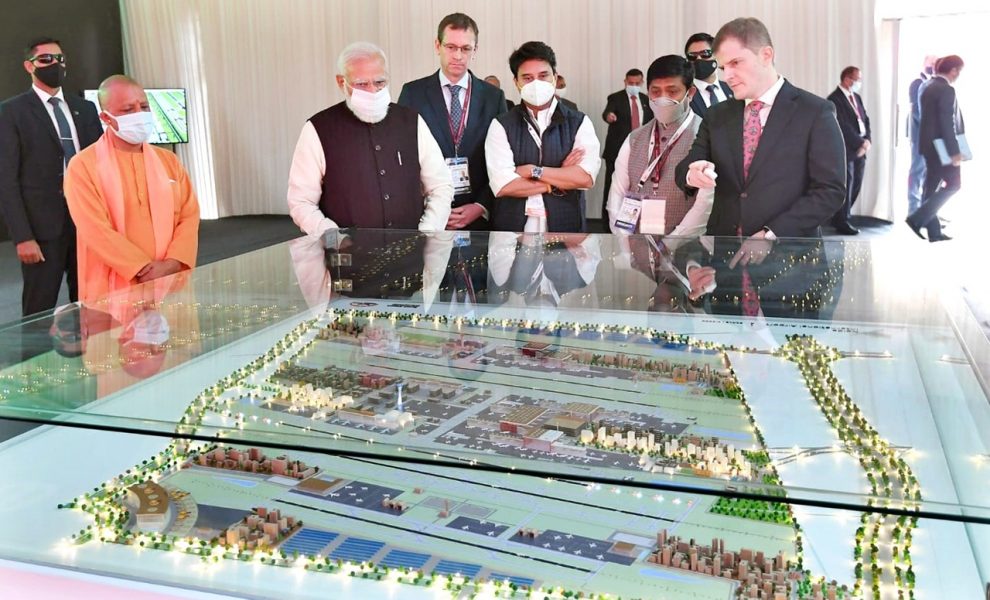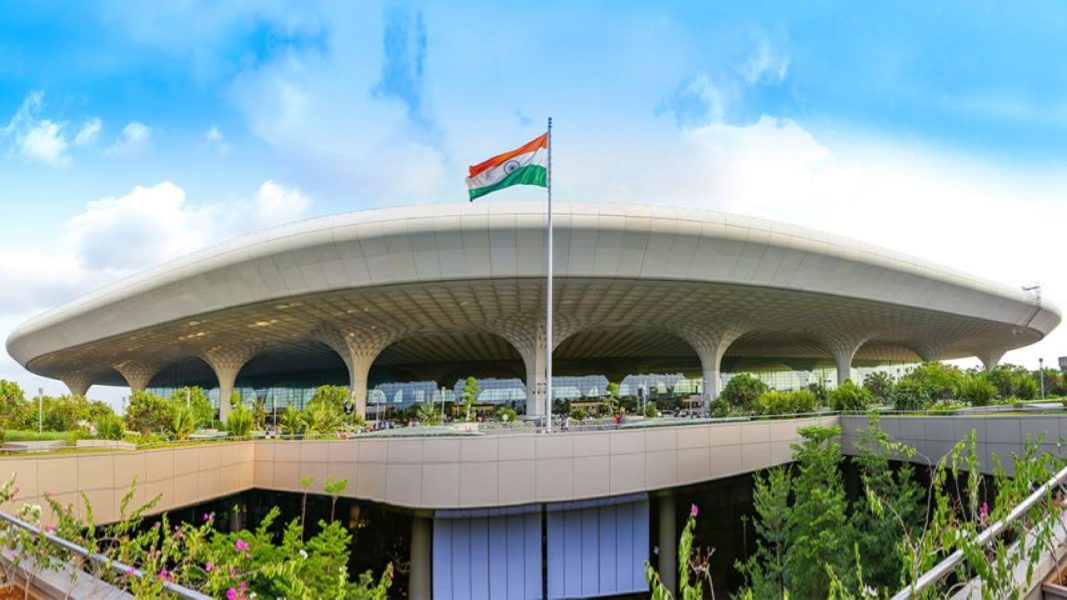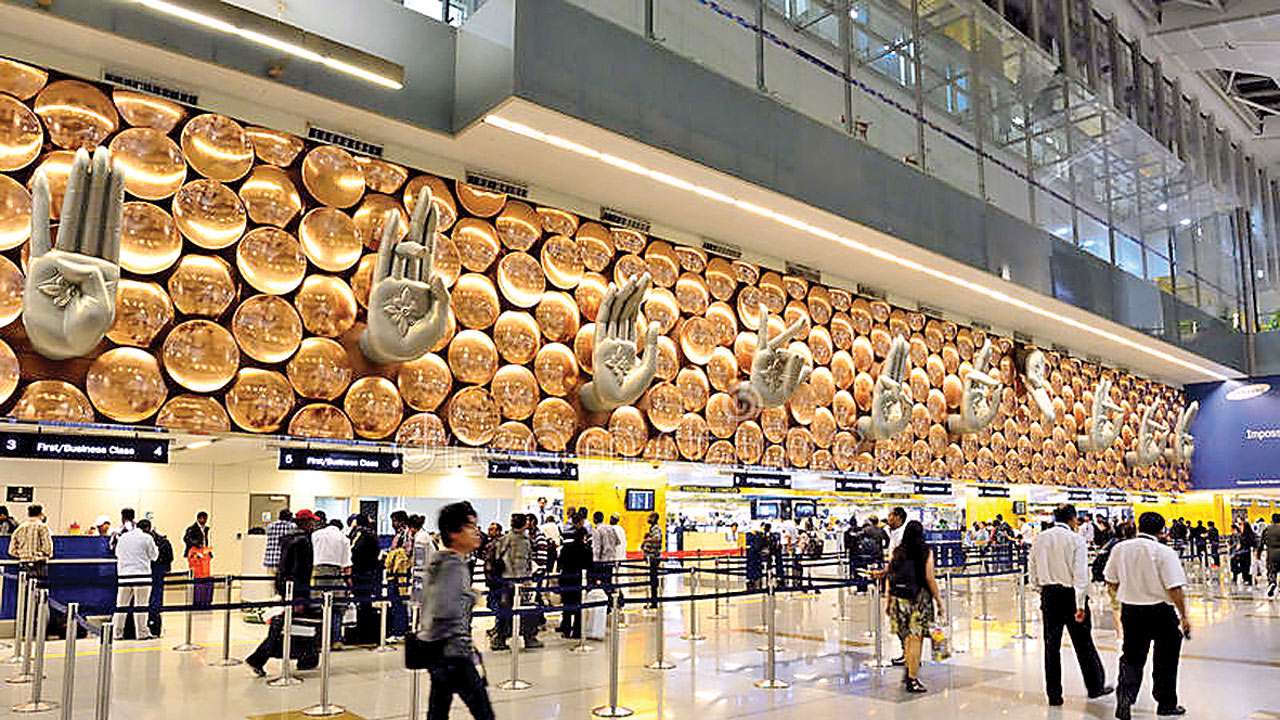Saudi Arabia has announced that it will lift a travel ban on expats from six countries including India that was introduced to contain the spread of the Coronavirus (Covid-19) pandemic.
The directives will allow direct entry of fully vaccinated expatriates without the need to spend 14 days in transit outside their countries before entering the Kingdom.
(Image Courtesy - Outlook India)
The Saudi interior ministry has, however, maintained that a five-day quarantine was a must for the entrants, irrespective of their vaccination status, with all measures subject to constant evaluation by the country’s health authorities. The other five countries it listed are Pakistan, Brazil, Vietnam, Egypt and Indonesia.
Saudi Arabia's Ministry of Interior issued the directive saying that changes will commence at 1 AM on December 1.
The English-language newspaper said that expats arriving from these countries must spend five days in quarantine regardless of their Coronavirus vaccination status outside the Kingdom.
Earlier in February, the direct entry ban was imposed due to a global spike in Covid-19 cases.
(Image Courtesy - Arabian Business)
The ban covered Lebanon, UAE, Egypt, Turkey, the US, Britain, Germany, France, Italy, Ireland, Portugal, Switzerland, Sweden, Brazil, Argentina, Pakistan, South Africa, India, Indonesia and Japan.
The travel ban also applied to travellers who transited through any of the 20 countries in the 14 days before a planned visit to the country.
While flights to and from Saudi Arabia were first suspended on March 14, 2020, travel by land, sea and air resumed on January 3, 2021.
Cover Image - Al Arabiya
Read next
India has taken up with Pakistan through diplomatic channels regarding Islamabad’s denial of overflight clearance for the newly launched Srinagar-Sharjah flight.
Pakistani authorities had granted overflight clearance to GoFirst flights to operate the Srinagar - Sharjah sector on 23rd, 24th, 26th and 28th of October.
Subsequently, Pakistan put the clearance for the same flight on hold for the period October 31 to November 30, 2021.
Asked about the issue at a media briefing, Ministry of External Affairs Spokesperson Arindam Bagchi said, “We have taken up the matter with the government of Pakistan for overflight clearances of flights from Srinagar to Sharjah. We have not received a response.”
Asked if India was considering reciprocal measures and stop overflight clearances to PIA flights to Kuala Lumpur and Singapore, Bagchi said, “I don’t have any indication of whether we are looking at the kind of steps you had alluded to.”
“This matter was promptly taken up with Pakistan through diplomatic channels and we have requested Pakistan to grant overflight clearance for this flight in the larger interest of the common people who have booked tickets on this route,” sources said.
Pakistan had permitted the flight to operate over its airspace initially. According to flight-tracking service Flightradar24, services up to October 30 crossed Pak airspace but on November 2, the plane had to turn west over the Arabian Sea, increasing flying time by an hour.
Go First said it planned to continue offering the service but adding an hour extra of flying would end up raising fuel and ticket costs.
Former chief minister Omar Abdullah expressed disappointment, reminiscing about a similar initiative in 2009 when the first once a week international flight from Srinagar to Dubai was started but had to be discontinued in a few months.
“Very unfortunate. Pakistan did the same thing with the Air India Express flight from Srinagar to Dubai in 2009-10. I had hoped that Go First Airways being permitted to overfly Pak airspace was indicative of a thaw in relations but alas that wasn’t to be,” Abdullah said.
When Shah had inaugurated the flight in Srinagar, Abdullah had tweeted, “Pakistan had a change of heart and allowed flights originating from Srinagar to use its airspace.”
Read next
On October 21, 2016, the government unveiled the regional connectivity scheme (RCS) UDAN (Ude Desh Ka Aam Nagrik) to connect small towns with aerial routes to give the quintessential common man or 'aam admi' the opportunity to travel by air.
Between 2019 and 2024, 100 new airports, as well as heliports and water aerodromes, will be built to support the UDAN scheme. In addition, after four rounds of bidding, 780 valid routes have been assigned to shortlisted airlines.
The Airports Authority of India has set aside about INR 25,000 crores for five years, from 2019 to 2024, to complete the construction of 100 new airports, heliports, and water dromes.
As of now though, out of 780 valid routes, only 359 routes have been made operational, according to official sources.
The update on airports shows that while in the fiscal year 2019-20, nine airports were developed, 14 airports had been developed till the third quarter of 2020-21 (i.e. December 2020), out of the proposed target of 26 airports which were to be developed during that fiscal.
In the current fiscal (2021-22) and 2022-23, 20 airports apiece are to be developed while 25 airports in 2023-24 are to be developed.
Therefore as per the information provided by the civil aviation ministry itself, till December 2020, only 23 airports had been developed under the UDAN scheme, even as it is halfway through its tenure period.
As far as parameters adopted for identifying airports under the UDAN scheme is concerned, the civil aviation ministry has said that it is a market-driven scheme, under which interested airlines, based on their assessment of demand on particular routes, submit their proposals at the time of bidding.
An airport that is included in the awarded routes of RCS - UDAN and requires up-gradation or development for commencement of RCS operations, is developed under the "revival of unserved and underserved airports" scheme.
The UDAN scheme is funded through an INR 50 levy on flight tickets on major routes. The levy accounts for 80% of the viability gap funding provided to the airlines, with the remaining 20% provided by state governments.
The government’s regional connectivity scheme UDAN celebrated its 4th anniversary on April 27. But it has witnessed slow progress of implementation, as not even 50% of the route have been operationalised and according to a report, the second wave of the pandemic which started from mid of March 2021, may impact it further going forward. Rating agency ICRA in its report said that there is likely to be a further delay of two years in achieving the target of operationalising as many as 100 unserved and underserved airports and starting at least 1000 RCS routes by 2024.
Aimed at enhancing regional connectivity through fiscal support and infrastructure development, the maiden flight under the Ude Desh Ka Aam Nagrik (UDAN) scheme was flagged off by Prime Minister Narendra Modi from Shimla for Delhi on April 27, 2017. As of May 31, only 47% of total routes and 39% of airports (unserved and underserved) have been operationalised under UDAN, according to ICRA.
(With Inputs from NDTV)
Read next
Prime Minister Narendra Modi launched the Noida International Airport at Jewar in Gautam Buddha Nagar on November 25.
The Prime Minister laid the foundation stone of the airport whose first phase will be completed by 2024. The Noida airport will be India's first net-zero emissions airport. The airport is spread over more than 1300 hectares of land.
The development of the airport is in line with the vision of the Prime Minister towards boosting connectivity and creating a future-ready aviation sector. This airport will be the second international airport to come up in Delhi NCR.
It will help decongest the Indira Gandhi International (IGI) Airport. The Prime Minister credited the double engine government -- both state and central government being run by BJP -- for turning Uttar Pradesh into the most connected region.
The airport will provide employment opportunities to the local population and will also boost the local economy. As per PMO, the airport is strategically located and will serve the people of cities including Delhi, Noida, Ghaziabad, Aligarh, Agra, Faridabad and neighbouring areas.
The airport will be the logistics gateway of northern India. Due to its scale and capacity, the airport will be a game-changer for Uttar Pradesh. It will unleash the potential of Uttar Pradesh to the world, and help establish the state on the global logistics map.
It further said that for the first time, an airport in India has been conceptualised with an integrated multi-modal cargo hub, with a focus on reducing the total cost and time for logistics.
"The dedicated cargo terminal will have a capacity of 20 lakh metric tonne, which will be expanded to 80 lakh metric tonnes. By facilitating the seamless movement of industrial products, the airport will play a crucial role in helping the region attract huge investments, boost rapid industrial growth, and enable them to reach local products to national and international markets. This will bring new opportunities for numerous enterprises, and also create tremendous employment opportunities," the statement added.
The Noida International Airport will be implemented in four phases and the work on the first phase is scheduled to be completed in 36 months, said Civil Aviation Secretary Rajiv Bansal.
The PM is accompanied by CM Yogi Adityanath and Union Civil Aviation Minister Jyotiraditya M. Scindia.
"The traffic of 12 million passengers per year is expected in the first phase and by the completion of final phase i.e. between 2040-50, the capacity of Jewar airport will be to handle 70 million passengers per year," Bansal said. He also informed that the Uttar Pradesh government is spending INR 4,326 crore on the acquisition of land and rehabilitation and resettlement.
Bansal said that the Prime Minister is personally monitoring the project.
As per PMO, the airport will develop a Ground Transportation Centre that will feature a multimodal transit hub, housing metro and high-speed rail stations, taxi, bus services and private parking. This will enable seamless connectivity of the airport with the road, rail, and metro.
Noida and Delhi will be connected to the airport through hassle-free metro service. All major nearby roads and highways like the Yamuna Expressway, Western Peripheral Expressway, Eastern Peripheral Expressway, Delhi-Mumbai Expressway and others will be connected to the airport.
The airport will also be linked to the planned Delhi-Varanasi High-Speed Rail, enabling the journey between Delhi and the airport in only 21 minutes.
The airport will also house a state-of-art Maintenance, Repair and Overhauling (MRO) Service. The design of the airport is focused on low operating costs and seamless and fast transfer processes for passengers.
The airport is introducing a swing aircraft stand concept, providing flexibility for airlines to operate an aircraft for both domestic and international flights from the same contact stand, without having to re-position the aircraft.
This will ensure quick and efficient aircraft turnarounds at the airport while ensuring a smooth and seamless passenger transfer process.
(Image Courtesy - The Quint)
It will be India's first net-zero emissions airport. It has earmarked dedicated land to be developed as a forest park using trees from the project site.
NIA will preserve all native species and be nature positive throughout the development of the airport.
It will be executed by the international bidder Zurich Airport International AG as a concessionaire.
The groundwork for the first phase regarding land acquisition and rehabilitation of the affected families has been completed.
In poll-bound Uttar Pradesh, various development projects have been inaugurated in recent months. On October 20, Modi inaugurated the Kushinagar international airport.
Currently, there are nine operational airports in Uttar Pradesh, including three international aerodromes at Lucknow, Varanasi and Kushinagar. Eight more airports, including the one at Jewar, will be coming up in three years.
The six other operational airports in the state are Agra, Gorakhpur, Kanpur, Prayagraj, Hindon and Bareilly.
On Wednesday, Civil Aviation Secretary Rajiv Bansal said five aerodromes are expected to be ready at Aligarh, Chitrakoot, Azamgarh, Moradabad and Shravasti in 2022.
In 2023, two more are expected to come up at Ayodhya and Muirpur.
Read next
The construction of the second airport in India's commercial capital is finally taking shape with the Adani Airport Holdings readying funding of up to INR 15,000 crore from the State Bank of India for the proposed airport in Navi Mumbai.
The group is said to have lined up one of the largest project financing loans from India's largest lender, the State Bank of India, signalling the return of CAPEX loans for infrastructure projects.
Sources in the know also told ET that the estimated project cost has further increased by INR 4,000 crore to INR 20,000 crore.
(Image Courtesy - Ahemdabad Mirror)
"Of the total cost, INR5,000 crore will be put by the Adani Group and the rest will come through borrowings," the source added.
The bank is said to have completed the project appraisal. It is now finalising the contours of the loan, which is likely to be long term, possibly of a 15-year tenor.
"It makes sense for a bank like SBI to go for such a long-term project loan as the lender is also seeking prudential credit opportunity," said an executive familiar with the matter.
Sources said, SBI would initially extend the proposed credit line but is likely to down-sell it to other interested lenders, Some foreign lenders appear interested in possible syndication; the source added.
(Image Courtesy - Scroll)
The Adani group obtained management control of the Mumbai airport from the GVK group in July and owns a 74% stake in Mumbai International Airport Limited (MIAL), which holds a 74% stake in the Navi Mumbai airport. The rest is owned by the Maharashtra government.
MIAL is the company that operates Mumbai airport. After the acquisition of GVK's Mumbai International Airport, India's second busiest, and six other airports of AAI, Adani Airport Holdings Ltd accounts for 25% of all passenger traffic and 33% of air cargo.
With air passenger numbers estimated to grow as the industry comes out of the impact of the covid pandemic, airport infrastructure is set to see billions of dollars of investments as India races to fulfil its airport infrastructure needs.
While the Adani group capital investments are going to be in Navi Mumbai airport and AAI airports like Jaipur, Ahmedabad, Lucknow, Guwahati, Trivandrum and Mangalore, Jewar airport in Greater Noida is also set to see an investment of INR 5,000 crore till early 2024.
PM Narendra Modi laid the foundation stone of the airport today and the initial part of the first phase of the airport is set to be operational by February 2024.
(With Inputs from The Economic Times)
Read next
The pandemic has flipped the pecking order of world airports. This month Delhi Airport is busier than Dubai International Airport (DXB) in terms of combined domestic and international seat capacity deployed by airlines.
At 30.87 lakh, Indira Gandhi International Airport (IGIA) is the seventh busiest airport globally in November, slightly ahead of DXB at 30.72 lakh, according to UK-based air consultancy firm OAG.
In pre-pandemic November 2019, DXB was at number 3 and IGIA at number 10 on this criteria.
While Dubai (DXB) remains the world’s busiest international airport by seats, IGIA does not figure in the list of top 10 international airports due to continued restrictions on scheduled foreign flights by India.
The revival of domestic air travel in India — where airlines are now allowed to fly as many flights within the country as they did pre-Covid — has led to a revival of footfalls at airports, making IGIA overtake DXB in overall domestic plus international seat capacity.
In pre-pandemic times, nearly 60% of the international traffic between India and the rest of the world flew foreign airlines. Of them, Gulf carriers took the lion's share in terms of both points to point and connecting traffic.
Dubai International Airport (DXB) Image Courtesy - (ifly A380 - Airbus)
"If India can take steps to lower the steep operating cost structures for its airlines and the latter can mount more nonstops to the rest of the world, including distant continents, then the blow to airlines of nearby hubs will be big. Transit traffic to and from India is a big source of filling the planes of these airlines," said an airline official.
The 10 busiest airports overall (domestic plus international seat capacity) in November, according to OAG, are - Atlanta Hartsfield-Jackson, Dallas Fort Worth, Chicago O’Hare, Guangzhou, Denver, Los Angeles International, Delhi IGIA, Dubai DXB, Tokyo Haneda and Shenzhen.
The 10 busiest airports by international seat capacity alone this month are - Dubai DXB, London Heathrow, Amsterdam, Paris CDG, Frankfurt, Istanbul, Doha, Madrid Adolfo Suarez-Barajas, New York JFK and Dublin.
“This month again, half of the top 10 global airports, by seat capacity, are located in the US. Atlanta (ATL) remains in the first place, and Chicago O’Hare (ORD) drops from second to third place… Dubai (DXB) retains its position as the busiest international airport this month, whilst London Heathrow (LHR) climbs up the rankings into second-place from fourth-place last month. Amsterdam (AMS) moves down to the third place. Eight European airports remain in the Top 10 Busiest International Airports this month with Dublin (DUB) replacing Antalya (AYT) and moving into tenth-place. New York’s JFK airport also returns, coming into ninth place. Only half of the current Top 10 airports were in the Top 10 in November 2019. Still missing are Singapore (23), Hong Kong (27), Incheon (45) and Bangkok (63) as recovery in Asia continues to falter.”OAG
(With Inputs from The Times of India)






Comment